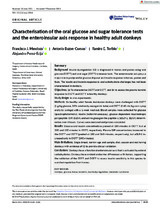Mostrar el registro sencillo del ítem
Characterisation of the oral glucose and sugar tolerance tests and the enteroinsular axis response in healthy adult donkeys
| dc.contributor.author | Mendoza, Francisco J. | |
| dc.contributor.author | Buzón-Cuevas, Antonio | |
| dc.contributor.author | Toribio, Ramiro E. | |
| dc.contributor.author | Pérez-Écija, Alejandro | |
| dc.date.accessioned | 2023-11-08T09:31:18Z | |
| dc.date.available | 2023-11-08T09:31:18Z | |
| dc.date.issued | 2022 | |
| dc.identifier.issn | 2042-3306 | |
| dc.identifier.uri | http://hdl.handle.net/10396/26150 | |
| dc.description.abstract | Background Insulin dysregulation (ID) is diagnosed in horses and ponies using oral glucose (OGTT) and oral sugar (OSTT) tolerance tests. The enteroinsular axis plays a major role in postprandial glucose disposal and insulin response in horses, ponies and foals. The insulin and incretin response to oral carbohydrate challenges has not been characterised in donkeys. Objectives (a) To characterise OGTT and OSTT, and (b) to assess the plasma incretin response to OGTT and OSTT in healthy donkeys. Study design In vivo experiments. Methods Six healthy adult female Andalusian donkeys were challenged with OGTT (1 g/kg glucose, 20% solution by nasogastric tube) and OSTT (0.45 mL/kg corn syrup orally by syringe) with a 1-week washout. Blood samples were collected for glucose (spectrophotometry), insulin (radioimmunoassay), glucose-dependent insulinotropic polypeptide (GIP, ELISA) and active glucagon-like peptide-1 (aGLP-1, ELISA) determination over 6 hours. Curves were analysed and proxies calculated. Results Glucose and insulin concentrations peaked at 180 minutes in OGTT, but at 300 and 150 minutes in OSTT, respectively. Plasma GIP concentrations increased in the OGTT and OSTT (peaked at 180 and 360 minutes, respectively), but aGLP-1 increased only in OGTT (240 minutes). Main limitations Single breed, narrow age and sample, diet, season and not having donkeys with evidence of ID to provide clinical validation. Conclusions Donkeys have a functional enteroinsular axis that is activated by enteral carbohydrates. Donkeys have evident endocrine differences with horses, supporting the validation of the OSTT and OGTT to assess insulin sensitivity in this species to avoid extrapolation from horses. | es_ES |
| dc.format.mimetype | application/pdf | es_ES |
| dc.language.iso | eng | es_ES |
| dc.publisher | Wiley | es_ES |
| dc.rights | https://creativecommons.org/licenses/by-nc-nd/4.0/ | es_ES |
| dc.source | Equine Vet J.;54:1123–1132 (2022) | es_ES |
| dc.subject | Donkeys | es_ES |
| dc.subject | Glucose | es_ES |
| dc.subject | Horse | es_ES |
| dc.subject | Incretins | es_ES |
| dc.subject | Insulin dysregulation | es_ES |
| dc.subject | Metabolic syndrome | es_ES |
| dc.title | Characterisation of the oral glucose and sugar tolerance tests and the enteroinsular axis response in healthy adult donkeys | es_ES |
| dc.type | info:eu-repo/semantics/article | es_ES |
| dc.relation.publisherversion | https://doi.org/10.1111/evj.13544 | es_ES |
| dc.rights.accessRights | info:eu-repo/semantics/openAccess | es_ES |

